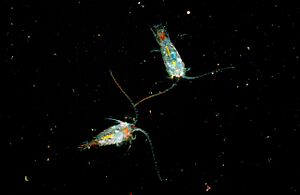Epischurella baikalensis facts for kids
Quick facts for kids Epischurella baikalensis |
|
|---|---|
 |
|
| Conservation status | |
| Scientific classification | |
| Genus: |
Epischurella
|
| Species: |
baikalensis
|
| Synonyms | |
|
|
The Epischurella baikalensis is a tiny animal that lives in Lake Baikal. It was once known as Epischura baikalensis. This small creature is a type of copepod, which is a very small crustacean. It is found only in Lake Baikal. This means it is endemic to that lake.
This tiny animal is super important for Lake Baikal. It makes up 80% to 90% of all the small living things in the lake. It helps keep the lake's water clean. The Epischurella baikalensis is only about 1.5 to 2 millimeters long. That's about the size of a small ant!
Contents
What is a Copepod?
Copepods are very small crustaceans. They are related to crabs and shrimp. Most copepods live in the ocean. But some, like the Epischurella baikalensis, live in fresh water. They are a big part of zooplankton. Zooplankton are tiny animals that float in water. They are a food source for many bigger animals.
Where Does it Live?
The Epischurella baikalensis lives all through the water in Lake Baikal. It can be found from the top to the bottom. These tiny animals move around a lot during the day and night. They also change where they live during the year. This helps them find good places to eat and reproduce. It also helps them hide from animals that want to eat them.
Life Cycle and Reproduction
The Epischurella baikalensis has two main groups born each year. One group is born in winter and spring. The other group is born in summer. Each of these groups lives for about one year.
A female copepod can lay many eggs. She can produce about 10 egg sacs. She lays a new sac every 10 to 20 days. There are usually equal numbers of male and female copepods. The way they grow and reproduce changes with the seasons. This is because the lake's conditions are different in winter and summer.
Why is it Important?
The Epischurella baikalensis plays a huge role in keeping Lake Baikal clean. It filters the water. It eats tiny algae and bacteria. This helps to keep the water clear and healthy. Without these tiny copepods, Lake Baikal would not be as clean as it is.
About its Name
The scientific name for this animal is Epischurella baikalensis. Sometimes, people mistakenly call it "Epischura baicalensis". But the correct original name was given by G. O. Sars in 1900. He called it Epischura baikalensis.
Later, scientists looked at its genes. They decided to use the name Epischurella. This name was first suggested by Smirnov in 1936. So, the name Epischurella baikalensis is now used by many groups. This includes the IUCN Red List. Other groups still use the older name.



